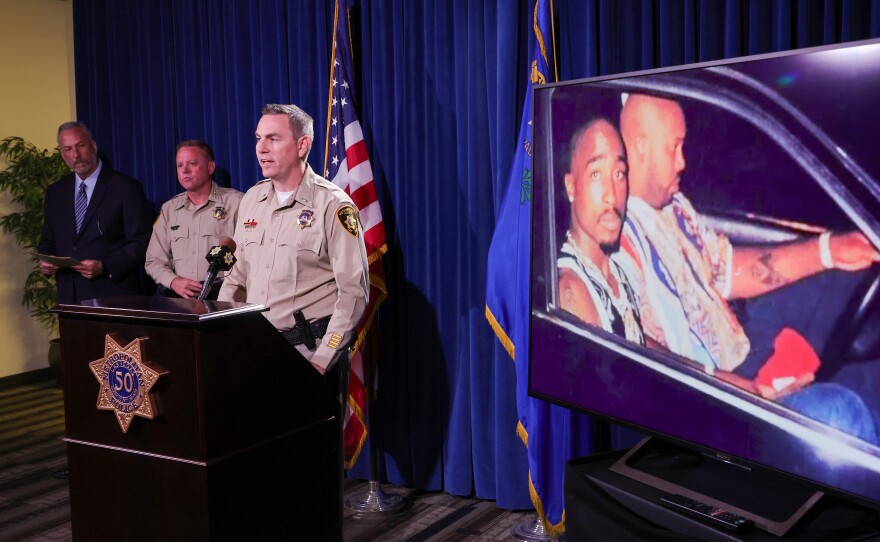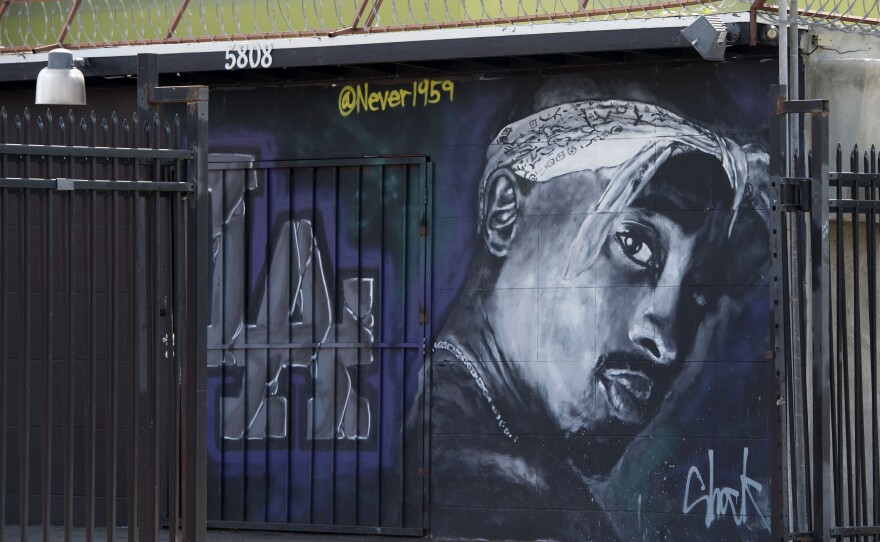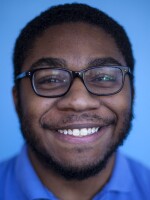In recent weeks, there have been surprising new developments in the murder case of the rapper Tupac Shakur, which felt as if it might be stuck in a resolved-but-unsolved limbo forever. This is a complicated new chapter in one of hip-hop's longest, most well-known mythologies, and one that is revealing ways in which the story has lost some of its nuance in the course of becoming folklore.
On Sept. 29, a Nevada grand jury indicted Duane "Keffe D" Davis (sometimes Keefe D) in connection with the 1996 killing. Chief Deputy District Attorney Marc DiGiacomo described Davis as the "on-ground, on-site commander" who "ordered the death."
The arrest marks the first major movement in a 27-year-old case that has built up its own mythos over time, but Davis, who is scheduled to be arraigned on one count of murder in Las Vegas on Oct. 19, is a familiar figure in the investigation. The conversation around the case tells its own story about the blurred lines of information, what is known versus what is believed, what qualifies as evidence and how the truth of an incident can be warped by its circumstances.
Tupac himself always had the makings of a mythic figure, and in realizing that myth has come to represent our collective need for martyrs and closed loops. His story has been told many times by many people with their own agendas.
Named for an Indigenous rebel, he was conceived while his mother, Afeni, was on trial as a member of the Panther 21, accused of planning a coordinated attack that included a bombing. (The group was exonerated when Afeni represented them in court.) A performing arts student in Baltimore, Tupac ascended from extra and dancer in the Oakland group Digital Underground to actor and solo superstar in only a few years, and several faceoffs with law enforcement merely enhanced his legend.
That legend has grown larger than the man himself, in part because his brief career produced so much music, commerce and conflict beyond his death.
He built up a reputation as an indestructible force while alive, particularly after a 1994 shooting at Quad Studios, where he resisted being robbed at gunpoint. In the aftermath, he accused The Notorious B.I.G. and Bad Boy Records head Sean "Puffy" Combs of being privy to or orchestrating the attack. He was rolled into court in a wheelchair a day after the shooting and found guilty of first-degree sexual abuse for "forcibly touching [a] woman's buttocks" in a 1993 hotel incident. In October 1995, after Suge Knight posted Tupac's bond (in some versions with backing from their shared label Interscope), the rapper joined Knight's Bad Boy rival, Death Row Records in LA, becoming the face of a West Coast movement.
In allying with Suge Knight, an enforcer turned cutthroat businessman, and Death Row, Tupac inherited the thug tycoon's many beefs. Suge encouraged his resentment for Bad Boy and The Notorious B.I.G. The resentment lingered through the summer of 1996, when Tupac released the Bad Boy diss "Hit 'Em Up."
The night of Sept. 7, 1996, Tupac and Knight attended the Mike Tyson fight at the MGM Grand in Las Vegas. Death Row employee/associate Trevon Lane spotted a man who had robbed him of his chain — later identified as Orlando Anderson — and told Tupac. Surveillance footage displayed the ensuing altercation, in which Tupac, Knight and others jumped Anderson. A few hours later, at a stop light, four men in a white Cadillac pulled up beside the black BMW that Tupac and Knight were riding in. A man opened fire on the car, hitting Tupac four times and Knight once, before the Cadillac sped off. Tupac died from his injuries on Sept. 13.

Gossip has defined the Tupac case from the beginning and been key to the subsequent mythmaking of many of the players. Some have speculated that Bad Boy was involved in the 1996 shooting — a sentiment that has reemerged since news of Davis' arrest — based on a connection between Davis and the label.
That suspicion, too, has managed to stay stuck in the gears of the unsolved case, despite immediate pushback: A few weeks after the shooting, in Time magazine, Knight dismissed the idea that the feud with Bad Boy had anything to do with Tupac's death: "It's something that's trumpeted by the press ... It's not true." When The Notorious B.I.G. was killed in 1997, the deaths of the two icons, former friends turned coastal competitors, became forever entangled.
As the investigation begins, an immediate impasse
Initial investigations by the Las Vegas and Compton police departments revealed the timeline of events surrounding the shooting.
From the outset, members of the South Side Crips were considered likely suspects in the Tupac shooting. Both Anderson and Davis were part of a South Side set known as the Burris Street Crew. In October 1996, Anderson was arrested in a gang sweep on an outstanding warrant, and held for questioning in connection with Tupac's murder by Compton police, but he was released two days later for lack of evidence and never charged with the shooting.
Members of the Tupac and Death Row entourages, upholding a street ethic, were largely uncooperative. "We were hoping he would tell us who shot him," homicide Sgt. Kevin Manning said of Knight. "He didn't give us anything beneficial." Knight told Primetime Live: "I don't get paid to solve homicides."
By January 1997, two narratives were forming: Outsiders were saying the cops had no interest in solving the crime, and cops were saying no one was talking. "We have no direct evidence, nor do we have a witness," Manning told the Las Vegas Sun. "That's where we stand until somebody comes forward and is willing to stand up and give us accurate information." In February, Manning said, "We consider Mr. Anderson to be a suspect in the shooting, but at this moment, we have no direct evidence to connect him to the crime."
Yafeu Fula, a member of Tupac's group Outlawz known as Yaki Kadafi, who told police he could identify the shooter, was killed in an unrelated shooting in New Jersey in November 1996. In early 1997, two witnesses told the Los Angeles Times that they saw Tupac's shooters but were never asked by Las Vegas police to view pictures of possible suspects.
An MTV special report from March 1997, which first aired nine days after The Notorious B.I.G. was shot and killed in LA, revealed the contents of a 29-page affidavit prepared by Compton police, which outlined the context of the Lane chain snatching. That same month, a Vanity Fair story called "To Die Like A Gangsta" embodied the prevailing sentiment surrounding the Tupac case: that it was a puzzle to be solved. "Who killed Tupac remains a mystery," it said. "While there are plenty of suspects — East Coast rappers, Crips, Suge's enemies, Suge's friends — police have no solid leads."
A May 1997 feature in Vibe painted a more accurate picture: "There are no easy answers to the myriad questions surrounding Tupac's death. But it has become clear that the rap star's killing — and the three homicides that followed — are only the most visible tragedies in a tangled web of intrigue that extends deep into the L.A. underworld." It wasn't so much a "mystery" as an evidentiary nightmare, difficult to substantiate. On the one-year anniversary of the shooting, Manning told the Sun, "We're at a standstill."
In a March 1998 deposition for a wrongful death suit filed by the Shakur estate, in which Anderson was named as Tupac's killer, Anderson made changes to his story and lied under oath, according to The New York Times. In May 1998, Anderson was killed in a gang shootout in Compton that cops believe was unrelated to the case. That December, the Washington Post explored many rumors surrounding Tupac's death: Some people believed that his death was a setup; some people believed that he wasn't dead at all.
An industry of competing narratives arises
In a 2002 investigative report for the Los Angeles Times titled "Who Shot Tupac Shakur?" Pulitzer-winner Chuck Philips again pointed the finger at Anderson, but also stated that The Notorious B.I.G. was the mastermind behind a murder-for-hire plot, agreeing to pay $1 million for the shooting on the condition they use his gun. Though the South Side Crips did have connections to Tupac's Bad Boy rivals — Davis, who had personal history with Knight, had been hired by Bad Boy to work as security in Los Angeles — no meaningful link between Biggie and the shooting has ever been found.
Anderson, for his part, could never be tied to the murder in any official capacity. In the 1997 Vibe story, Las Vegas detective Brent Becker told reporter Rob Marriott, "We have no one who has talked to us that can tell us more than 'Orlando Anderson did it.' If I say John Doe killed President Kennedy, does that mean that he did it? If someone says that you killed Kennedy, is it fair to call you a suspect?" In the same story, Afeni Shakur rebutted: "It was clear to me from Day One that the Las Vegas police never had any intention of solving the case of my son's murder."

In the years since, several participants have elaborated on the shooting and the case. Davis, who once said Anderson did the shooting, tells a more indefinite story in his 2019 book, Compton Street Legend. On the motive, he points to three contributing factors: Death Row jumping Anderson, Combs having a problem with the label, and Knight owing money. On the preamble: "I pulled out the Glock that Zip [Eric Martin, a New York hustler] had given me and tossed it in the backseat. Bubble Up [Terrence Brown] did the driving, Baby Lane [Anderson] and Freaky [Deandre Smith] were riding in the back." On the shooting itself: "Tupac made an erratic move and began to reach down beneath his seat," he claims. "Pac pulled out the strap, and that's when the fireworks started. One of my guys from the back seat grabbed the Glock and started bustin' back."
"I stand firm on the point that Tupac, Suge Knight and the rest of those n***** didn't have any business putting their hands on my beloved nephew, Baby Lane. Period. Them jumping on my nephew gave us the ultimate green light to do something to their asses," he wrote. "Tupac chose the wrong game to play and the wrong n***** to play with."
Beyond the celebrity profile of the superstar victim and the crime's contribution to an already sensational East vs. West narrative, a web of local context complicated the story further. Books from both the Compton cops on the inside of the original investigation and a subsequent LAPD investigation into both Tupac and Biggie's murders put Tupac at the center of a bubbling gang war, with the Trevon Lane chain-snatching setting off a deadly chain of events.
On Sept. 11, 1996, witnesses alleged that MOB Piru Bloods killed Bobby Finch, a bodyguard with ties to the South Side Crips. Shootings escalated in the weeks after. That October, the LA gang unit organized with the FBI and the ATF (Bureau of Alcohol, Tobacco and Firearms) to raid 37 homes, making 23 arrests, including the aforementioned arrest of Anderson.
On Sept. 12, LASD gang detective Paul Fournier told Compton cops Timothy Brennan and Robert Lane that an informant with ties to Piru Bloods and Death Row had identified Anderson as Tupac's shooter. According to the informant, when members of Death Row met up at Club 662 after the shooting, Trevon Lane told them that it was the same person they jumped at the MGM Grand. They didn't know Anderson's name but they knew he was Davis' nephew. By the time Anderson was arrested in October, Brennan and Lane say that several informants had identified him as Tupac's killer.
Other persons of interest came up throughout the investigation, but three were identified as those in the Cadillac: Brown, Smith and Davis. In the LAPD task force years later, the last lead detective, Greg Kading, got Davis to admit the details of the Tupac shooting he would later share publicly in Compton Street Legend. (Timothy Brennan and Robert Lane noted in their 2017 book Once Upon A Time In Compton, written with Lolita Files, that a federal judge levied allegations against Kading during a separate case, which led to his removal from the task force, as well as cases Kading worked on with the task force, including Davis', not being prosecuted. Kading was later cleared of wrongdoing by an internal affairs investigation into the matter.)
In the wake of the LAPD task force investigation, Davis has been very forthcoming with his version of the shooting, allegedly because he made a deal. "Tim [Brennan] and Bob [Lane] still aren't sure how Kading and the task force were able to grant Keefe D immunity on a case that belonged to Las Vegas," Lolita Files wrote.
"I sang because they promised I would not be prosecuted," Davis wrote in his book.
A break in the case is a familiar story, amidst the noise
It's easy to wonder why an arrest is being made in this case now, especially when it seems like law enforcement has been circling the suspect for years. The main reason is relatively straightforward: A witness has come forward.
A New York Times report on Davis' indictment notes that the witness, Denvonta Lee, a purported associate of the South Side Crips, told a Vegas grand jury that his roommate, Smith, the other man in the Cadillac's back seat, said he fired the gun. (Smith died in 2004.) But the indictment does not identify a shooter, echoing Davis' book in suggesting either Smith or Anderson could have pulled the trigger; it instead focuses on painting Davis as the run-in's ringleader.
Kading has long been critical of the previous investigations, and in Once Upon A Time In Compton, Brennan and Lane acknowledge that they should have interviewed Anderson more extensively, but didn't because the case had roots in Las Vegas, outside their jurisdiction. In a 2003 AllHipHop interview, Kevin Manning held his line: "As of this date, and it's been this way since day one, there is no evidence to submit to the District Attorney for a prosecution of anyone," he said. "As far as I'm concerned the whole world is a suspect, including you. We have not eliminated anyone."

After years of waiting, the search has now, at the very least, officially been narrowed. If anything, the case seems to demonstrate that there may be some distance between an unsolved case and an unprosecuted one.
As time has gone by with the case in stasis, a desire for closure has let unsubstantiated murmurs fester, growing into a latticework of conjecture. With every year that passes, the chasm has grown and people have sought to fill the space themselves.
The YouTuber DJ Vlad has probed nearly everyone associated with the case, including Davis, all sharing their various accounts of what happened. Countless fan sites have dedicated forums to various theories. The late N.W.A manager Jerry Heller said that Suge Knight put a hit out on Tupac. Knight said he was the actual target. The 2018 USA Network miniseries Unsolved dramatized the Kading investigation. 50 Cent recently joked that Combs should lawyer up. When asked about the rumors in 2016, one-time Bad Boy star Ma$e told The Breakfast Club, "We don't talk about things that are nonsense," but recently seemed to imply some sort of involvement. Combs' bodyguard pointed the finger at the LAPD. Each new wrinkle in the story has changed the dimensions of what's "true." At this stage, it's hard to imagine even a verdict preventing some version of the myth from living on forever.
Copyright 2023 NPR. To see more, visit https://www.npr.org. 9(MDAzMjM2NDYzMDEyMzc1Njk5NjAxNzY3OQ001))







